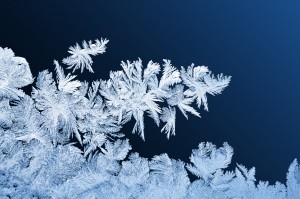WEDNESDAY, 30 MARCH 2016
The shell of the Namib Desert Beetle is equipped with a micropattern of alternating water-attracting and water-repelling channels that condense water vapour from the air for the beetle to drink; observations of this shell pattern provided the basis for the design of a synthetic silicon wafer that enables control and alteration of inter-droplet distance, which is a critical variable in frost formation. Removal and prevention of frost cost the US aviation industry around $240 million a year.
Removal and prevention of frost cost the US aviation industry around $240 million a year.In order to prevent frost from forming like this, the scientists produced silicon wafers with surfaces patterned to maximise inter-droplet distance. This maximisation was achieved in two ways: firstly, by the reproduction of the beetle shell’s micropatterns, allowing condensation droplets to form at an optimum distance. Secondly, by freezing specific parts of the synthetic wafer early on, the researchers were able to increase the distance between the supercooled droplets and the already frozen surface. The liquid on these wafers was then able to evaporate instead of being incorporated into the frost front, leading to dry zones acting as a barrier to frost formation.
Frost-free materials are highly desirable for use in extreme conditions such as for airplane exoskeletons and wind turbine blades, both of which are currently defrosted using harsh, expensive chemicals. Commercial applications of the new research findings are still a distance away; however, the researchers have proposed to engineer materials with optimized surfaces on which water can freeze in intricate patterns to keep surfaces dry – a promising and somewhat ironic way of conquering frost.
DOI: 10.1038/srep19131
Written by Shudong Li
